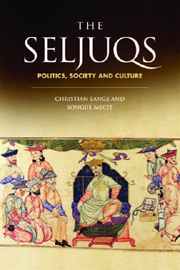Book contents
- Frontmatter
- Contents
- List of figures
- Acknowledgements
- List of abbreviations
- INTRODUCTION
- PART I POLITICS
- PART II SOCIETY
- Part III CULTURE
- 11 SHIˁI JURISPRUDENCE DURING THE SELJUQ PERIOD: REBELLION AND PUBLIC ORDER IN AN ILLEGITIMATE STATE
- 12 IN DEFENCE OF SUNNISM: AL-GHAZĀLĪ AND THE SELJUQS
- 13 ARABIC AND PERSIAN INTERTEXTUALITY IN THE SELJUQ PERIOD: ḤAMĪDĪ'S MAQĀMĀT AS A CASE STUDY
- 14 CITY BUILDING IN SELJUQ RUM
- 15 THE SELJUQ MONUMENTS OF TURKMENISTAN
- Index
13 - ARABIC AND PERSIAN INTERTEXTUALITY IN THE SELJUQ PERIOD: ḤAMĪDĪ'S MAQĀMĀT AS A CASE STUDY
from Part III - CULTURE
Published online by Cambridge University Press: 12 September 2012
- Frontmatter
- Contents
- List of figures
- Acknowledgements
- List of abbreviations
- INTRODUCTION
- PART I POLITICS
- PART II SOCIETY
- Part III CULTURE
- 11 SHIˁI JURISPRUDENCE DURING THE SELJUQ PERIOD: REBELLION AND PUBLIC ORDER IN AN ILLEGITIMATE STATE
- 12 IN DEFENCE OF SUNNISM: AL-GHAZĀLĪ AND THE SELJUQS
- 13 ARABIC AND PERSIAN INTERTEXTUALITY IN THE SELJUQ PERIOD: ḤAMĪDĪ'S MAQĀMĀT AS A CASE STUDY
- 14 CITY BUILDING IN SELJUQ RUM
- 15 THE SELJUQ MONUMENTS OF TURKMENISTAN
- Index
Summary
The relationship between Arabic literature, on the one hand, and Persian literature, on the other, falls under two major topics: the general impact of Arabic literature on Persian literature, and the transmission and adaptation of Arabic literary texts into Persian. This chapter seeks to examine the development of Persian literature in the Seljuq period by investigating the organic relationship that exists between this development and previous Arabic literary works. This approach relies on the concept of ‘intertextuality’ in literary studies which denies ‘an ultimate referent that would make possible the self-presence and meaning of a text’ and instead proposes to see texts as ‘fragments in open and endless relations with all other texts’. It is common knowledge that all universal traditions of literature constitute one progressive stage in a sequence of literary accomplishments that are established on former ones and contribute to the formation of others in the future, regardless of quality or merit. Classical Arabic and Persian literatures are no exceptions in this regard.
This chapter is concerned with a specific period and a particular region in the Middle East. The period under consideration is named by historians after the major ruling dynasty at the time, that is, the Seljuqs, and the region is the historic land of the Persians (bilād fāris) which covers the territories whose native citizens had Persian as their mother tongue. This would include, according to modern political borders, Iran with some territorial extensions on the periphery.
- Type
- Chapter
- Information
- The SeljuqsPolitics, Society and Culture, pp. 240 - 255Publisher: Edinburgh University PressPrint publication year: 2011



